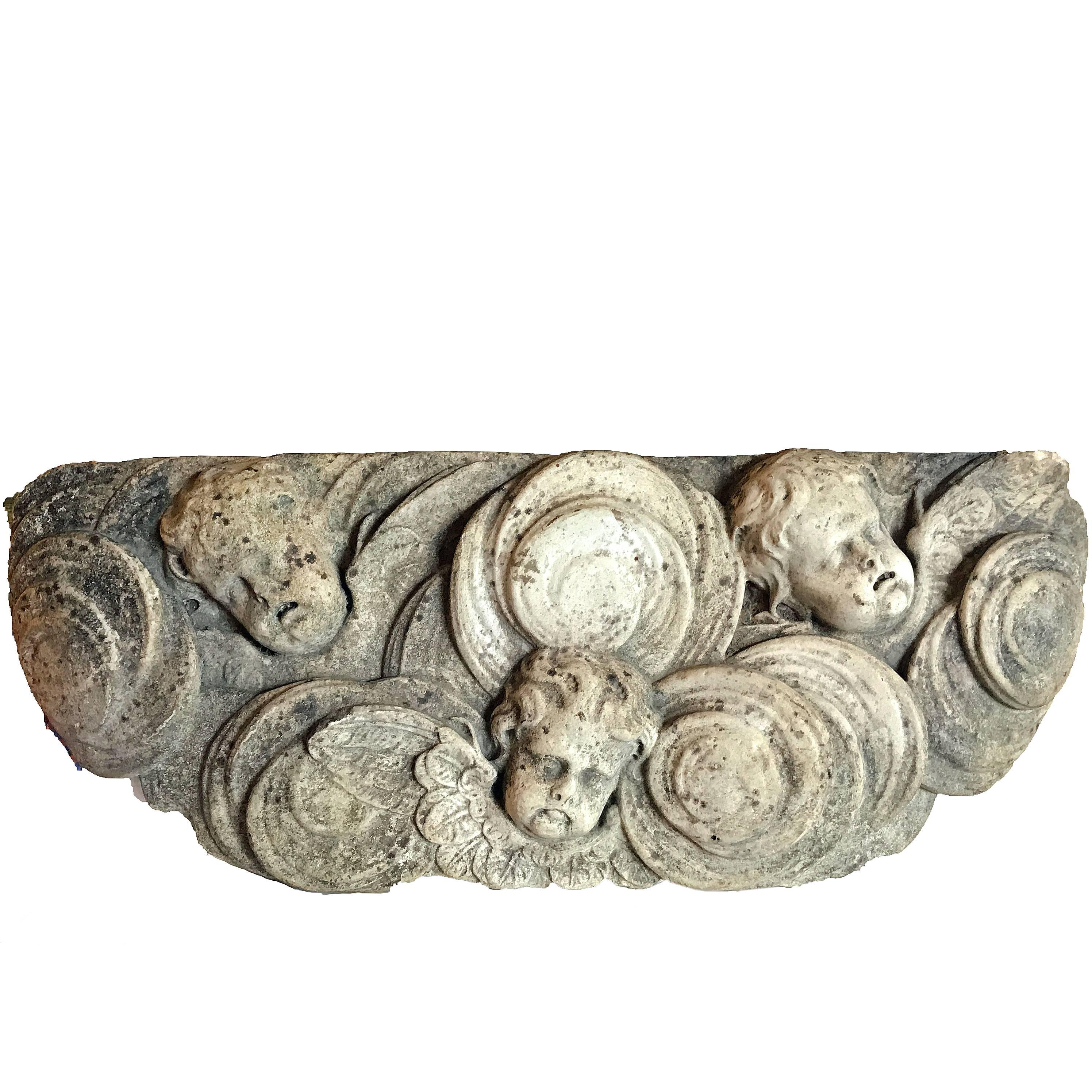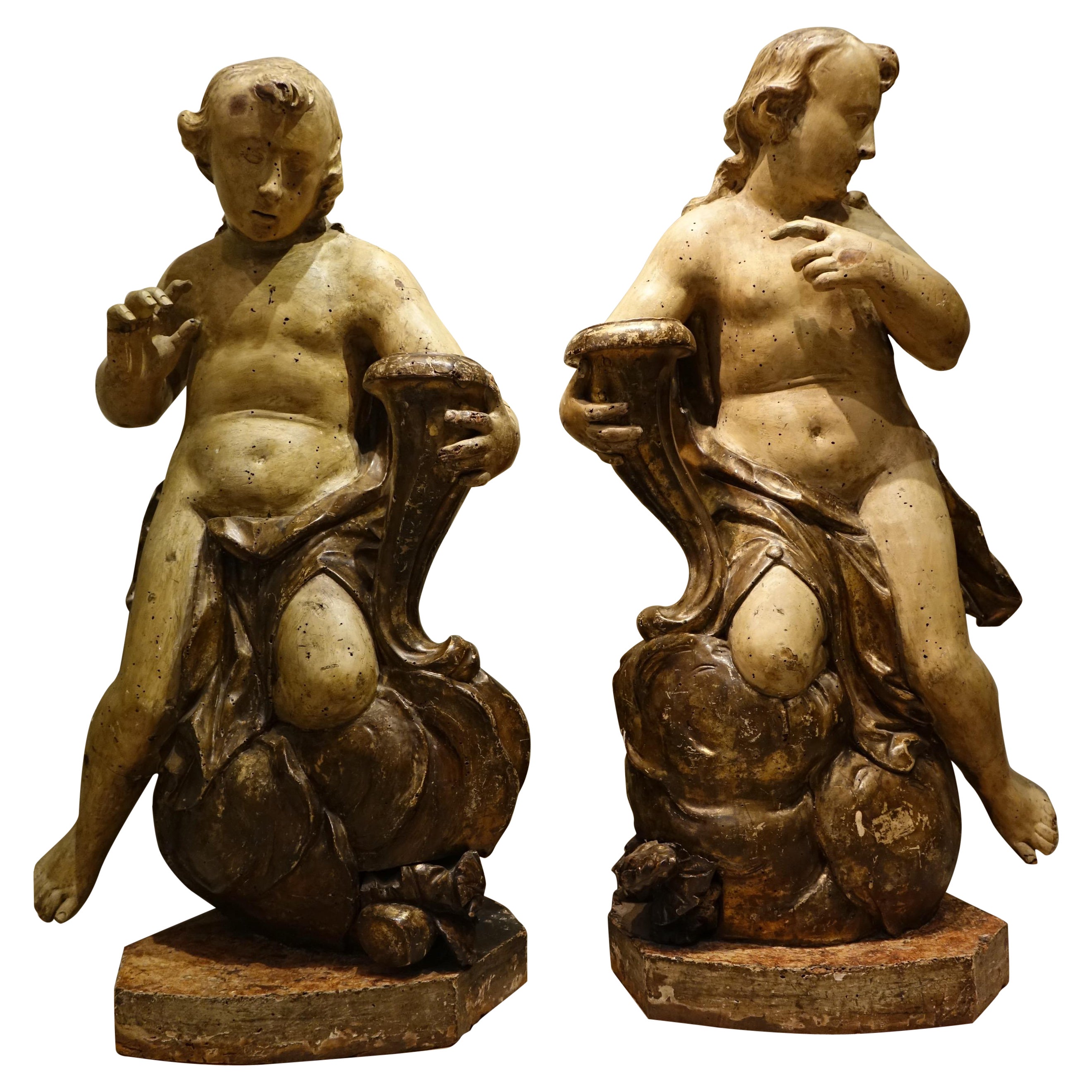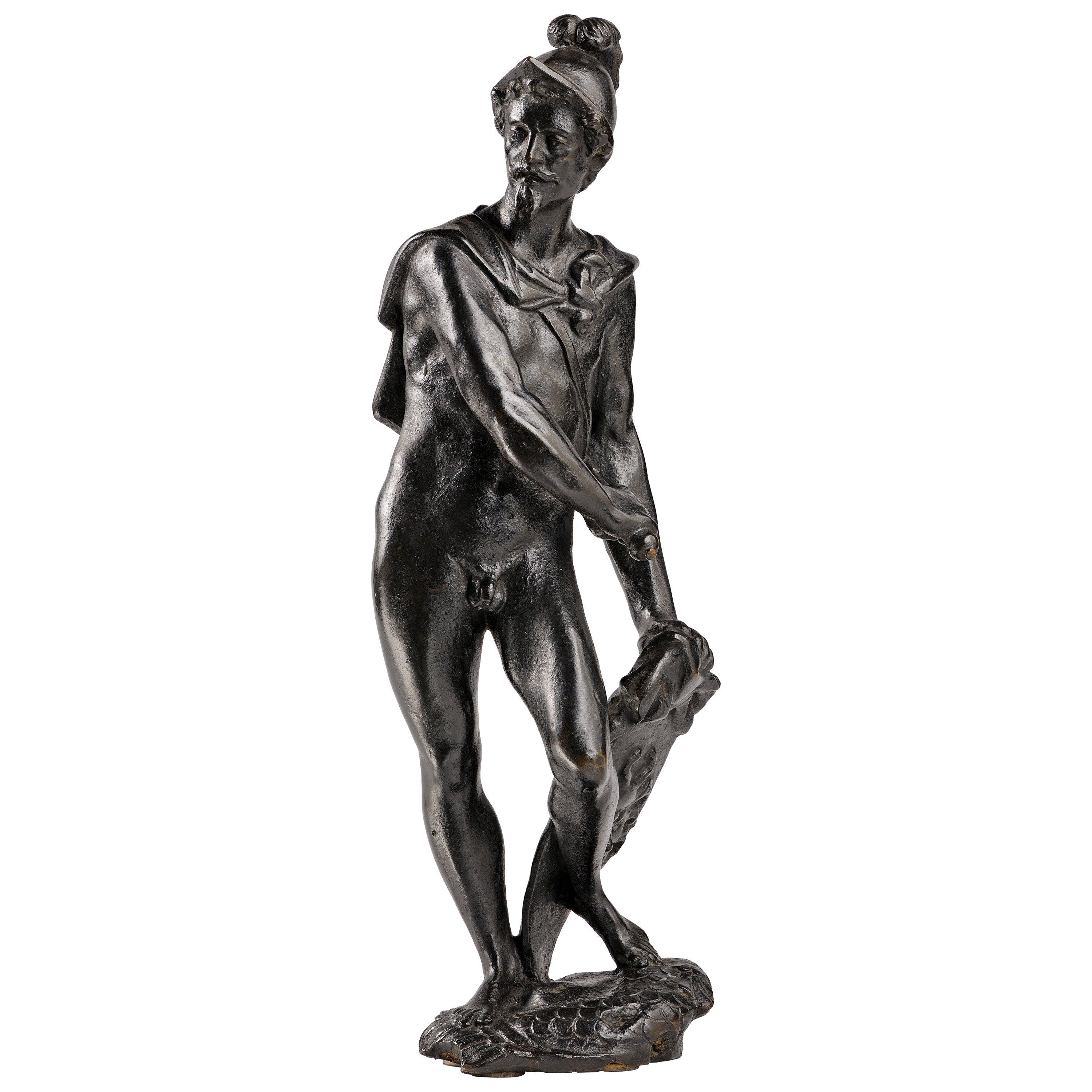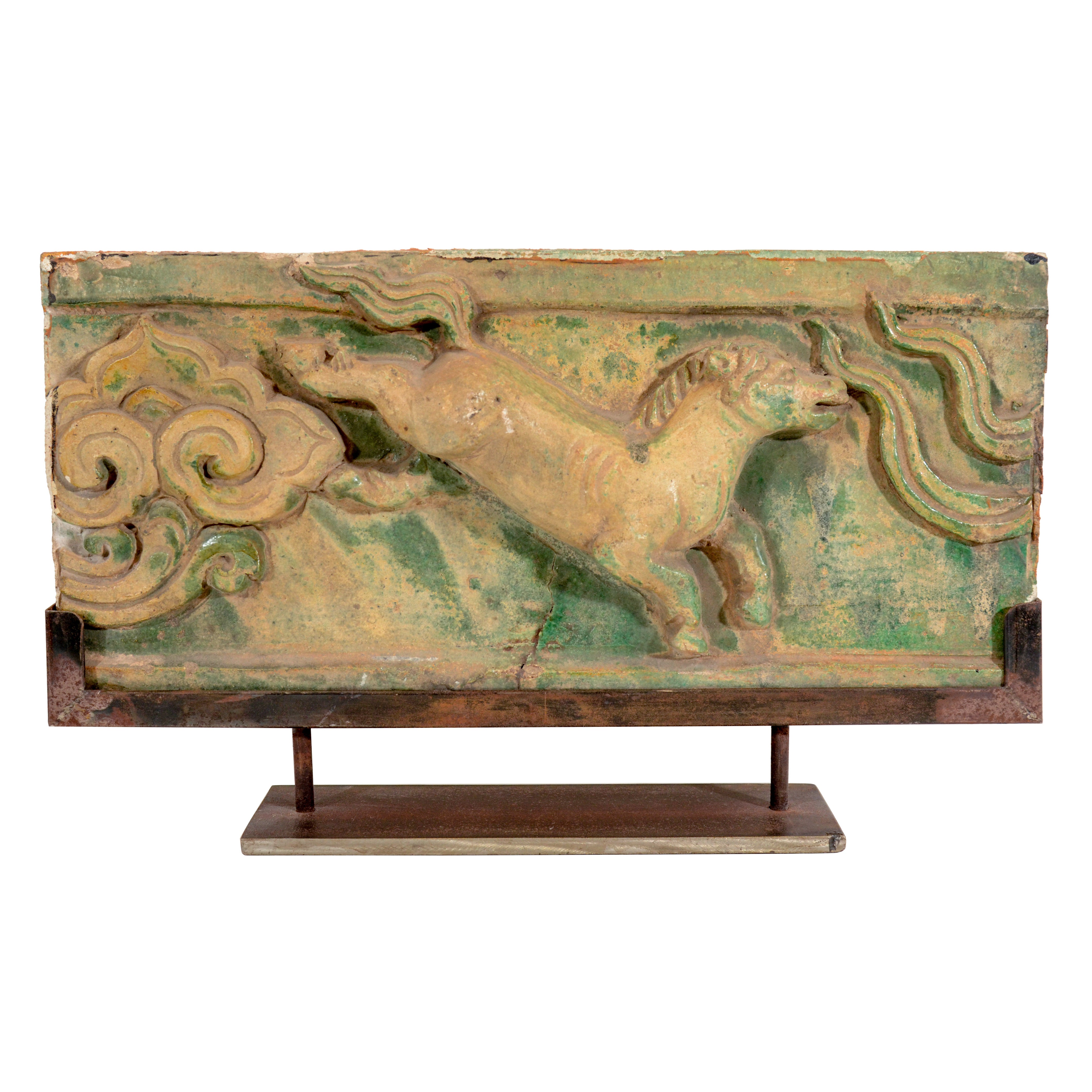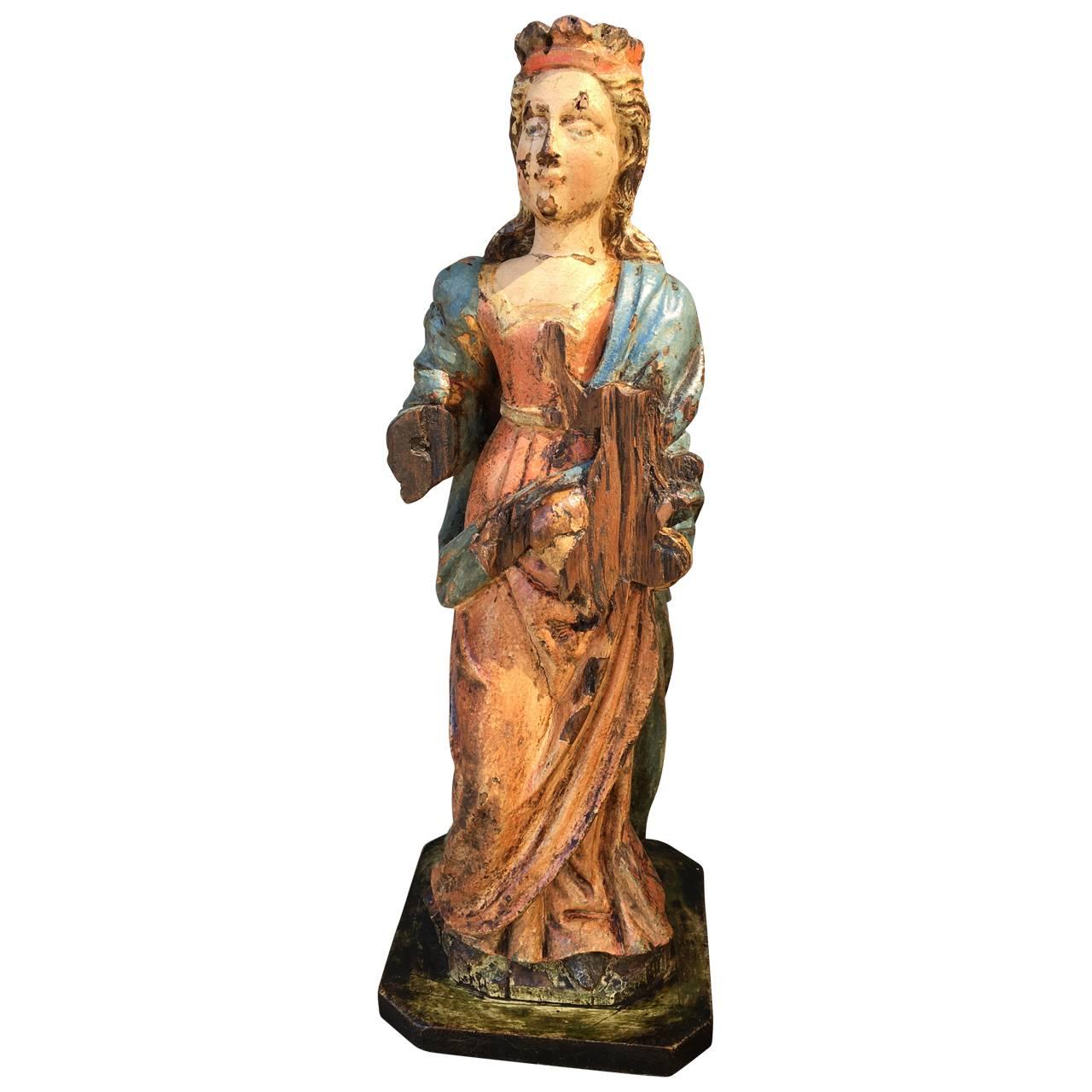Items Similar to Large Terracotta Relief - Lombardy, First Half of 17th Century
Want more images or videos?
Request additional images or videos from the seller
1 of 7
Large Terracotta Relief - Lombardy, First Half of 17th Century
About the Item
Large Terracotta relief of the flight into Egypt
Lombardy, first half of 17th century
Painted terracotta
91 x 85 x 11,5 cm
This event in the early life of Christ is recounted in the Gospel of Saint Matthew (2: 13-15). Joseph was warned in a dream that Herod was intent on killing the child Jesus and so he took Mary and the baby to Egypt for safety. This episode, both poignant and hopeful, has been portrayed many times.
The artist does not deviate from traditional iconography: Maria seated in a frontal position carrying the Child occupies the central position; the Angel assist in guiding the Holy Family and Joseph, behind the donkey closes the composition; the procession is followed by angels between the clouds. The palm tree, symbol of fertility in Egypt, is the miracle tree of the desert regions.
The baby Jesus is represented as a newborn baby carried in the arms of his mother. Unlike other episodes in the Childhood cycle, where Jesus is shown as an active subject; here, on the contrary, it is represented as a designated target and becomes an object in relation to the forces which surround it.
The main couple is the Virgin and the Child and the asymmetry is total between the four protagonists of the Flight: Mary represents the triumphant aspect of the episode, Joseph its share of humility and obedience; one is covered with noble linens, the other with rustic rags; in a frontal position and in motion on the donkey's back, Marie and the Child share a fusional relationship.
It is interesting that the artist chose to represent Maria with the Child almost in the round; Joseph, in profile is also carved in very strong relief, his head completely detached from the background while for the Angel, the palm tree and the clouds, the artist has chosen a more delicate relief. The backgrounds are treated in antique relief and the foreground figures, almost detached, in the round.
The theme of flight, both religious and universal, is an empathetic subject capable of arousing feelings of pity among the faithful.
This large high relief shows affinities in style and in composition with the Flight into Egypt sculpted by Gian Andrea Biffi for the apse of the Duomo in Milan, of which exist a terracotta version listed by Federico Zeri.
We find in both works a balanced and solemn composition, where emotions are controlled and the objective is to highlight reason instead of senses. Imbued with the Mannerist ideal of grace, these works are marked by the subtle penetration of the ancient world, reproposed as nostalgia for solemn beauty.
This trend reflects the political situation in the north of the country and more generally in the entire peninsula. The Milanese and Lombard scene of the second half of the 16th century and the beginning of the 17th century must be analyzed taking into account the particular position of the city: if for the Spanish Empire it represented a strategic military outpost, it was at the center of the conflict between the Catholic Church and the Reformed Church. As a result, the greatest contribution has been given by religious art in the face of an inferior civil artistic and architectural production.
By the last decades of the 16th century the refined, courtly style known as Mannerism had ceased to be an effective means of expression, and its inadequacy for religious art was being increasingly felt in artistic circles. Renouncing the independence acquired by humanism, for its autonomous and purely aesthetic ends, art was reduced to its social and religious function. It was once again becoming a "committed" art, a means at the service of a cause.
The Roman Catholic Church after the Council of Trent (1545–63) adopted a propagandistic stance in which art was to serve as a means of extending and stimulating the public’s faith in the church. To this end the church adopted a conscious artistic program which was paradoxically both sensuous and spiritual; while a naturalistic treatment rendered the religious image more accessible to the average churchgoer.
The arts present an unusual diversity in the Baroque period, chiefly because currents of naturalism and classicism coexisted and intermingled with the typical Baroque style. The Church intended to restore her unity and the collective sense of the faithful through a tightening of discipline, which required a severe and sober style.
The classicized tendency that evolved from this program was characterized by simple and balanced compositions imbued by classical sobriety, more delicate in form and restrained in expression. This high relief is a rare example of the idealistic classicizing style which during the XVII century formed a counterpart for the more emotional and theatrical Baroques sculptures.
- Dimensions:Height: 35.83 in (91 cm)Width: 33.47 in (85 cm)Depth: 4.53 in (11.5 cm)
- Style:Baroque (Of the Period)
- Materials and Techniques:
- Place of Origin:
- Period:
- Date of Manufacture:17th Century
- Condition:Wear consistent with age and use.
- Seller Location:Bruxelles, BE
- Reference Number:1stDibs: LU6666234762262
About the Seller
5.0
Vetted Seller
These experienced sellers undergo a comprehensive evaluation by our team of in-house experts.
1stDibs seller since 2022
6 sales on 1stDibs
Typical response time: 7 hours
- ShippingRetrieving quote...Ships From: Bruxelles, Belgium
- Return PolicyA return for this item may be initiated within 3 days of delivery.
More From This SellerView All
- Pair of Wooden Chairs, Lombardy, 17th CenturyLocated in Bruxelles, BEPair of beautifully carved wooden chairs Lombardy, first half of 17th century H 86 x L 48 x P 43 cm Pair of “da balia” (nanny) chairs. The backrest is decorated with winged myt...Category
Antique 17th Century Italian Renaissance Chairs
MaterialsWood
- A Captive Soldier - Italie (Rome), 17th centuryLocated in Bruxelles, BEA Captive Soldier Gilt Bronze, Lost Wax Italie (Rome), 17th century H 17 x Dia 10 cm H 6 2/3 x Dia 4 inch The 17th century witnessed a flourishing of artistic expression across Eur...Category
Antique 17th Century Italian Baroque Figurative Sculptures
MaterialsBronze
- Cerberus, Italy, 17th CenturyLocated in Bruxelles, BECerberus Black painted stone Italy, 17th century Measures: 80 x 69 x 36cm (one head missing) Cerberus, cruel monster, fierce and strange, Through his wide threefold throat barks as a dog Over the multitude immers'd beneath. His eyes glare crimson, black his unctuous beard, His belly large, and claw'd the hands, with which He tears the spirits, flays them, and their limbs Piecemeal disparts (Dante, Inferno, Canto VI). Cerberus figure seated, in his role of ferocious guardian of the underworld; he shows a nervous musculature, an adherent skin which reveals the ribs, long and robust limbs; his heads are broad and the eyes set well apart. Painted in black to amplify his menacing look, the infernal guardian is depicted with his famous attributes, writhing his heads, growling and barking furiously. Cerberus, in Greek mythology, was the monstrous watchdog of the underworld – also known as the “hound of Hades” – preventing the dead from leaving, and making sure that those who entered never left. A child of Typhon and Echidna, he was part of a monstrous family, which included Orthus, the Lernaean Hydra, and the Chimaera as well. Only on three occasions Cerberus was tricked by visitors of Hades: Heracles did it with his strength, Orpheus with his music. In "The Inferno", Dante places Cerberus as the guardian of the third circle of Hell. With his three mouths, Dante saw Cerberus as a beast that was synonymous with the sin of Gluttony. Virgil gets past the monster by throwing mud in his three mouths, temporarily choking him. Very rare are the representations of Cerberus in ancient statuary...Category
Antique 17th Century Italian Renaissance Figurative Sculptures
MaterialsStone
- Large Cast and Chiseled Bronze Plaque - Saint Sebastian, Rome 17th centuryLocated in Bruxelles, BELarge Cast and Chiseled Bronze Plaque Saint Sebastian after the model by Guido Reni (Capitoline Museum) Rome, 17th century Large rectangular bronze plaque depicting the martyrdom of...Category
Antique 17th Century Italian Baroque Figurative Sculptures
MaterialsBronze
- Plateau with two breasts, attribute of Saint Agatha - 17th centuryLocated in Bruxelles, BEPlateau with two breasts, attribute of Saint Agatha Southern Italy, 17th century Polychrome and gilded wood 20 x 14,5 x 15 cm Born into a noble lineage, Agatha came into the world ...Category
Antique 17th Century Italian Baroque Figurative Sculptures
MaterialsWood
- Italian Memento Mori skull - 17th centuryLocated in Bruxelles, BEItalian Memento Mori skull Marble North of Italy, 17th century H 9 x L 7 x P 14 cm At the turn of the 16th century, they were the height of fashi...Category
Antique 17th Century Italian Renaissance Figurative Sculptures
MaterialsMarble
You May Also Like
- A Rare French Marble Relief of Putti Fragment, Late 17th CenturyLocated in Sheffield, MAA Rare French Marble Relief of PuttiFragment Late 17th Century Century Height 14 in. Width 33 in. Carved throughtout with three putti figures Provenance: Private Collector, Bor...Category
Antique 18th Century and Earlier French Baroque Statues
MaterialsStone, Marble
- Pair of large baroque statues , Italy Genova 17th centuryLocated in PARIS, FRPair of large statues carved in the round, probably representing cerulean angels (although there is no evidence of wings on the back), or allegories of fortune (in which case we can ...Category
Antique 17th Century Italian Baroque Figurative Sculptures
MaterialsWood
- Italian Late Renaissance Bronze Perseus, First Third of the 17th CenturyLocated in Milano, ITPerseus (or Mars?) Padua, first half of the 17th century follower of Tiziano Aspetti (Padua, 1559 - Pisa, 1607) bronze with dark patina State of conservation: the dark patina cov...Category
Antique 1620s Italian Renaissance Figurative Sculptures
MaterialsBronze
- 18th Century, Terracotta ReliefLocated in New York, NYAn 18th century terracotta relief panel from an old Chinese building. Finely crafted horse image with traces of original color. Includes custom-made ...Category
Antique 18th Century and Earlier Chinese Sculptures
MaterialsTerracotta
- Pair of 17th Century AngelsLocated in TOULOUSE, FRPair of angels in polychrome and gilded wood. They each carry a cornucopia receiving two iron arms of light decorated with flowers and foliage. Charming expression of these smiling...Category
Antique 1610s Spanish Other Figurative Sculptures
MaterialsWood
- Early 17th Century SculptureLocated in Copenhagen, KAmazing Baroque sculpture of a woman wearing a crown in original paint. Her hands are missing. Colors are untouched, recently cleaned off from a thick dark coating, I have images fro...Category
Antique Early 17th Century French Baroque Figurative Sculptures
MaterialsOak
Recently Viewed
View AllMore Ways To Browse
Cia Torino
Dark Vador
David Slaying Goliath
Denise Delavigne Marble
Denise Delavigne
Dental Anatomy
Edme Antony Paul Noel
Giovanni Girardi
Giuseppe Cappe Porcelain
Giuseppe Cappe
Grand Tour Seated Hermes Statue
Guido Cacciapuoti On Sale
Hermes Winged Hat
Infant Of Prague Crown
Jerrican Chanel
Josef Lorenzl On Sale
Kevin Kelly Knife
Lalique Aphrodite
